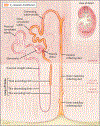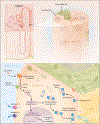Molecular physiology of water balance
- PMID: 25830425
- PMCID: PMC6444926
- DOI: 10.1056/NEJMra1404726
Molecular physiology of water balance
Figures




Comment in
-
Molecular Physiology of Water Balance.N Engl J Med. 2015 Jul 9;373(2):196. doi: 10.1056/NEJMc1505505. N Engl J Med. 2015. PMID: 26154805 No abstract available.
-
Molecular Physiology of Water Balance.N Engl J Med. 2015 Jul 9;373(2):196. doi: 10.1056/NEJMc1505505. N Engl J Med. 2015. PMID: 26154806 No abstract available.
References
-
- Verney EB. The antidiuretic hormone and the factors which determine its release. Proc R Soc Lond B Biol Sci 1947; 135:25–106. - PubMed
-
- Fenton RA, Knepper MA. Mouse models and the urinary concentrating mechanism in the new millennium. Physiol Rev 2007;87:1083–112. - PubMed
-
- Windle RJ, Forsling ML, Smith CP, Balment RJ. Patterns of neurohypophysial hormone release during dehydration in the rat. J Endocrinol 1993;137:311–9. - PubMed
Publication types
MeSH terms
Substances
Grants and funding
LinkOut - more resources
Full Text Sources
Other Literature Sources
Medical
Molecular Biology Databases
